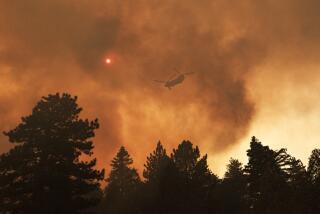Alaska Volcano Erupts, Sends Ash 7 Miles High : Nature: No injuries are reported. Scientists are unable to say whether mountain may explode again soon.
- Share via
ANCHORAGE, Alaska — A volcano that had been dormant for 23 years rumbled to life on Thursday, sending a black cloud of ash and steam 7 miles into the air.
The billowing cloud from the 10,197-foot Redoubt volcano, 110 miles southwest of here, passed over Anchorage but dusted several smaller communities to the north with gray, gritty soot.
“It was like a real fine sleet,” said Doug Breza, a service station employee in the town of Wasilla, 50 miles north of Anchorage. “All the cars are sort of coated with dust.”
No injuries were reported, although health authorities in the region advised people with respiratory difficulties to remain inside. Supermarket bag boys out retrieving carts wore surgeon-style masks in some communities to keep from breathing ash as it fell, and a smattering of businesses closed early for fear dust in the air would damage computer equipment.
However, by late Thursday, the health warnings were lifted.
There are no communities within 50 miles of the mountain, one of several on-again, off-again volcanoes in the towering Alaska Range on the west side of Cook Inlet.
Seven of 11 workers at a crude oil storage yard 20 miles from the volcano were evacuated by airplane as a precaution against flooding. But no flooding was reported.
State seismologists and officials with the U.S. Geologic Survey said that some steam was still spewing from the volcano late Thursday, but they said that the eruption, which occurred around 11:15 a.m. PST, lasted only a few minutes. There is no way to tell if the mountain, which has blown five times in this century, will erupt again soon, they said.
“It wouldn’t surprise us if we did get a buildup of activity and another eruption,” said Charlotte Rowe, a seismologist at the University of Alaska-Fairbanks.
The mountain, one of about 40 active volcanoes in the region, began showing a marked increase in seismic activity last Friday. By Wednesday, monitoring devices were recording tremors as frequently as one a minute, scientists said. But seismic activity nearly stopped by Thursday afternoon, they said.
Weather throughout the region was overcast when the volcano erupted, so few people saw the initial column of ash, which observers said rose to between 35,000 and 40,000 feet.
A pair of F-15 fighter pilots from Elmendorf Air Force Base in Anchorage flew directly over the volcano on a training run about 15 minutes before it blew. On their way back 20 minutes later, they saw a giant cloud of black ash rising from the clouds below.
“Imagine a big thunderhead,” one of the pilots, Capt. Steve Stoddard, said later. “It was very dark and it was rising fast.” In 10 minutes, he said, the cloud grew from 25,000 feet high to more than 35,000 feet, and the planes flew around it to avoid the dust. Passengers in jetliners coming and going from Anchorage also saw the plume.
One of two Air Force E-3A AWACS surveillance planes based at Elmendorf left for a base in Washington state shortly after the eruption because there is a hangar for only one plane here and authorities were concerned that volcanic dust could damage sensitive electronic equipment on board.
In Tyonek, an Athabascan Indian settlement 50 miles north of the volcano, people could smell ash and see it gradually darkening snow banks, but the ash was too thin to see falling.
“It wasn’t that bad,” said Emil McCord Sr., the village council president. He said that, when the same mountain erupted in 1952, “it got dark as midnight and we could feel the mountain rumble.” This time no one felt anything, he said.
In Anchorage, people saw a long, dark cloud pass over the city around midday, but, apparently, no ash fell. By Thursday night, weather forecasters said, the ash clouds had drifted hundreds of miles northeast, toward the Canadian border. The region is mostly mountains and tundra, with little population. No ash was reported falling in populated areas.
Falling ash from the volcano was heaviest in the Matanuska Valley north of Anchorage, where cars and people had been skidding on a layer of ice. The cloud of ash served as a giant sanding truck.
“It’s amazing,” said John Stein, the mayor of Wasilla, a community of 3,500. “There’s enough stuff on the ground that it’s literally skid-proofed the entire country.”
More to Read
Sign up for Essential California
The most important California stories and recommendations in your inbox every morning.
You may occasionally receive promotional content from the Los Angeles Times.










